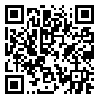BibTeX | RIS | EndNote | Medlars | ProCite | Reference Manager | RefWorks
Send citation to:
URL: http://jdm.tums.ac.ir/article-1-23-en.html
Background and Aims: Passive fit of prosthetic frameworks is a major concern in implant dentistry. Impression technique is one of the several variables that may affect the outcome of dental implants. The purpose of this study was to compare the three dimensional accuracy of direct and indirect abutment level implant impressions of ALL-ON-4 treatment plan.
Materials and Methods: A reference acrylic resin model with four Branemark fixtures was made according to All-On-4 treatment plan. Multiunit abutments were screwed into the fixtures and two special trays were made for direct and indirect impression techniques. Ten direct and ten indirect impression techniques with respective impression transfers were made. Impressions were poured with stone and the positional accuracy of the abutment analogues in each dimension of x, y, and z axes and also angular displacement (Δθ) were evaluated using a Coordinate Measuring Machine (CMM). Data were analyzed using T- test.
Results: The results showed that direct impression technique was significantly more accurate than indirect technique (P<0.001).
Conclusion: The results showed that the accuracy of direct impression technique was significantly more than that of indirect technique in Δθ and Δr coordinate and also Δx, Δy, Δz.
Received: 2011/10/22 | Accepted: 2012/07/5 | Published: 2013/09/16
| Rights and Permissions | |
 |
This work is licensed under a Creative Commons Attribution-NonCommercial 4.0 International License. |




